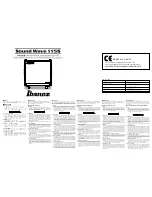
41
Over-Lubrication:
One of the most common causes of bearing failure is over-lubrication. The excess pressure of the lubricant often breaks, or “pops”
bearing seals or causes a build-up of heat, which can create stress and deformity.
To avoid over-lubrication:
1. Don't lubricate if the base line reading and base line sound quality is maintained.
2. When lubricating, use just enough lubricant to bring the ultrasonic reading to baseline.
3. As mentioned above, use caution. Some lubricants will need time to uniformly cover the bearing surfaces.
SLOW SPEED BEARINGS
Monitoring slow speed bearings is possible with the Ultraprobe 9000. Due to the sensitivity range and the frequency tuning, it is quite
possible to listen to the acoustic quality of bearings. In extremely slow bearings (less 25 RPM), it is often necessary to disregard the
display and listen to the sound of the bearing. In these extreme situations, the bearings are usually large (1/2" and up) and greased with
high viscosity lubricant. Most often low level sound will be heard as the grease will absorb most of the acoustic energy. If a high level
sound is heard, usually a crackling sound, there is some indication of deformity occurring.
On most other slow speed bearings, it is possible to set a base line and monitor as described.
FFT INTERFACE
There are two accessories that connect to an FFT via the Ultraprobe I/O port. They are the
9PC MP
(using a Miniphone connector to
the Computer or Recording Device) and the
9PC-BNC
(using a BNC connector to the FFT). These connectors enable an FFT to
receive the heterodyned, (translated) low frequency sound information detected from the Ultraprobe. In this instance it can be used to
monitor and trend bearings, including low speed bearings. It can also extend the use of the FFT to record all types mechanical
information such as leaking valves, cavitation, gear wear, etc.
3. GENERAL MECHANICAL TROUBLE SHOOTING
As operating equipment begins to fail due to component wear, breakage or misalignment, ultrasonic shifts occur. The accompanying
sound pattern changes can save time and guesswork in diagnosing problems if they are adequately monitored. Therefore, an ultrasonic
history of key components can prevent unplanned downtime. And just as important, if equipment should begin to fail in the field, the
ULTRAPROBE can be extremely useful in trouble shooting problems.
TROUBLE SHOOTING: 1. Use the Contact (Stethoscope) Module. 2. Touch test area(s): listen through headphones and observe the
display. 3. Adjust Sensitivity Dial until mechanical operation of the equipment is heard clearly and the bar graph can fluctuate. 4.
Probe equipment by touching various suspect areas. 5. If competing sounds in equipment being tested present a problem, try to "tune
in" to the problem sound by: a. Probing equipment until the potential problem sound is heard. b. Adjust Frequency slowly until the
problem sound is heard more clearly. 6. To focus in on problem sounds, while probing, reduce sensitivity gradually to assist in
locating the problem sound at its' loudest point. (This procedure is similar to the method outlined in LEAK LOCATION, i.e., follow
the sound to its loudest point.)
MONITORING OPERATING EQUIPMENT In order to understand and keep ahead of potential problems in operating equipment, it
is necessary to establish base data and observe shifts in that data. This can be accomplished by data logging readings directly into the
Ultraprobe or by recording sounds via the
Compact Flash Card
( see
Record WAV
in
Operational Overview
)
Proper Lubrication
Reduces Friction
Lack of Lubrication
Increases Amplitude Levels










































